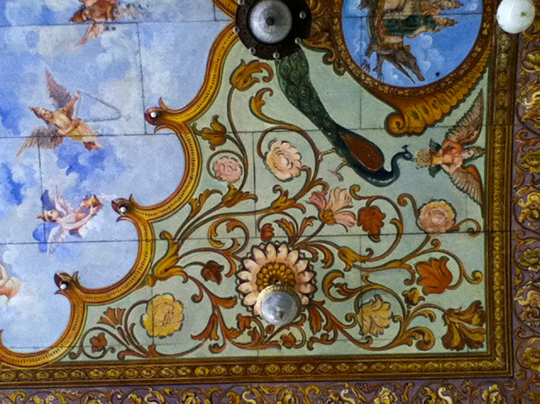Studio 25
Architect as a Verb
Blair Gardiner

This studio is available to students enrolled in ABPL90142 Studio C, ABPL90143 Studio D, and ABPL90115 Studio E.
Studio Description
The studio seeks to investigate the notion of Architect as a Verb (Tombesi, 2019). The focus is not on the Architect as a noun but the role of the actions of the subject. It does this in the context of designing a research and accommodation facility located in Mysore, India.
This studio provides students experience in international design contexts and encourages students to identify and engage with specific cultural practices, industrial contexts and socio-technical traditions.
STUDIO THEMES
Concepts of robustness and sensitivity in construction and its nexus with:
- Understanding the context in which the built environment design operates
- Reflecting on the utilisation of local labour, building craft, materials and skills
- Design as a socio-economic generator to equip and empower
- Design as a catalyst for contemporary sustainable and responsible practices
SITE
- Mysore, India
APPROACH
Analyse > (Design) Transfer > (Design) Modify > (Design) Commit > (Design) Test
- Analyse
- Put aside assumptions and collect information
- Observe and understand - local and contextual conditions
- Building industry practices, construction methods and techniques, material utilisation and craft skills;
- Climatic and geophysical conditions;
- Cultural, demographic, economic and social issues;
- Push-pull dynamics
- Interrogate the brief and the project objectives
- Transfer
- Combine the information
- Generate ideation guides
- Reflect on project objectives
- Modify
- Return to the analysis
- Refine the objectives
- Focus the approach
- Commit
- Refine the physical solution
- Modelling and Prototyping to fine-tune the response
- Test
- Map out the process
- Provide the output at a detailed level of resolution
- Return to the analysis
- Ratify and adjust
- Resolve and confirm
BRIEF
- Residential Research Facility
- Accommodation for groups or individuals (maximum 16 people) travelling to Mysore to carry out collaborative research
Studio Outcomes
DELIVERABLES
- Students to engage with the concepts of robustness and sensitivity in an international context;
- To encourage students to identify and engage with specific cultural practices, industrial contexts and socio-technical traditions;
- To stimulate systematic/creative thinking and problem-solving.
DELIVERABLES
- Individual research contributions into a cohesive group presentation of studio themes;
- Individual research-based design response development schemas;
- Individual research-based design proposal incorporating studio themes.
LEARNING OUTCOMES
Students should have the ability:
- To foster an understanding between social programs and spatial form;
- To identify and engage with specific cultural practices, industrial contexts and socio-technical traditions;
- To stimulate systematic/creative thinking and problem-solving;
- To assimilate research-based investigation into design responses that have broader flexible and adaptable applications accounting for the socio-technical nature of design and construction.
Studio Leaders
Helen Cheng is an Australian Architect and Urban Design practitioner residing in Singapore with 25+years of experience with design practices based in Singapore and Australia. Her extensive practise experience in Dhaka, Mumbai, Singapore and Australia.
She holds a B.Arch (Hons) 1999 from the University of Melbourne, subsequently obtaining practice experience with Allan Powell Architects, Wood Marsh, LAB Architects, Williams Ross, Hayball Architects and WOHA Architects Singapore. She recently completed a master by coursework, Master of International Urban and Environmental Management (Distinction) 2020 from RMIT.
Blair Gardiner is a Senior Lecturer in the Architecture Department at the Faculty of Architecture, Building and Planning of the University of Melbourne and a registered architect (VIC). He has a degree in Architecture and Arts and undertook studies in Italy related to industrial design and curatorial practice.
His interests include investigating built environment design applications to address community disadvantages and recently through digital design and digital fabrication techniques. He is also interested in the historical role of subcultures and hegemony in the public domain.
Readings & References
- Aquilino, M.J (2015) Abiding Architecture.
- http://masteremergencyarchitecture.com/2015/02/24/abiding-architecture-a-free-online-book-on-reconstruction-in-haiti-by-marie-aquilino/
- Architecture for Humanity (ed) (2006) Design Like You Give a Damn {2}: Building Change from the Ground Up. London, Thames & Hudson Ltd.
- Arrow, K, (1962), ‘The Economic Implications of Learning-by-Doing’, in Review of Economic Studies 29, Blackwell, pp 155-173.
- Chen, M. (2020) COVID-19, Cities and Urban Informal Workers: India in Comparative Perspective. Indian J Labour Econ, 1-6.
- https://doi.org/10.1007/s41027-020-00254-1
- Freason, A. (2017) India’s young architects must be taught to appreciate their design heritage, says Balkrishna V Doshi. Dezeen website: Dezeen
- https://www.dezeen.com/2017/07/12/balkrishna-doshi-interview-india-architects-must-appreciate-architecture-design-heritage/.
- Groak, S. (1992) The idea of building thought and action in the design and production of buildings . 1st ed. London ;: E & FN Spon.
- Misa, T. J., Brey, P. and Feenberg, A. (2003) Modernity and technology. Cambridge, Mass: MIT Press.
- MOIR, S. (2016) Building bridges: a comparative study of women working in the construction industry in India and the US. . Labour & Development 23, 18.
- TOMBESI, P. (2019) Easter Island as Search Field for EPFL Students in Architecture Lecture. Smart Living Lab: System Rapa Nui- Super Studio 2018.
- ULLAL, A and Tombesi,P. (2020) Dimensions and Correlates of Development in Construction, Journal of Construction in Developing Countries, http://web.usm.my/jcdc/earlyView/JCDC%20Early%20View_Andre%20Ullal.pdf
Schedule Mondays 09:00-12:00 and Thursdays 15:15-18:15